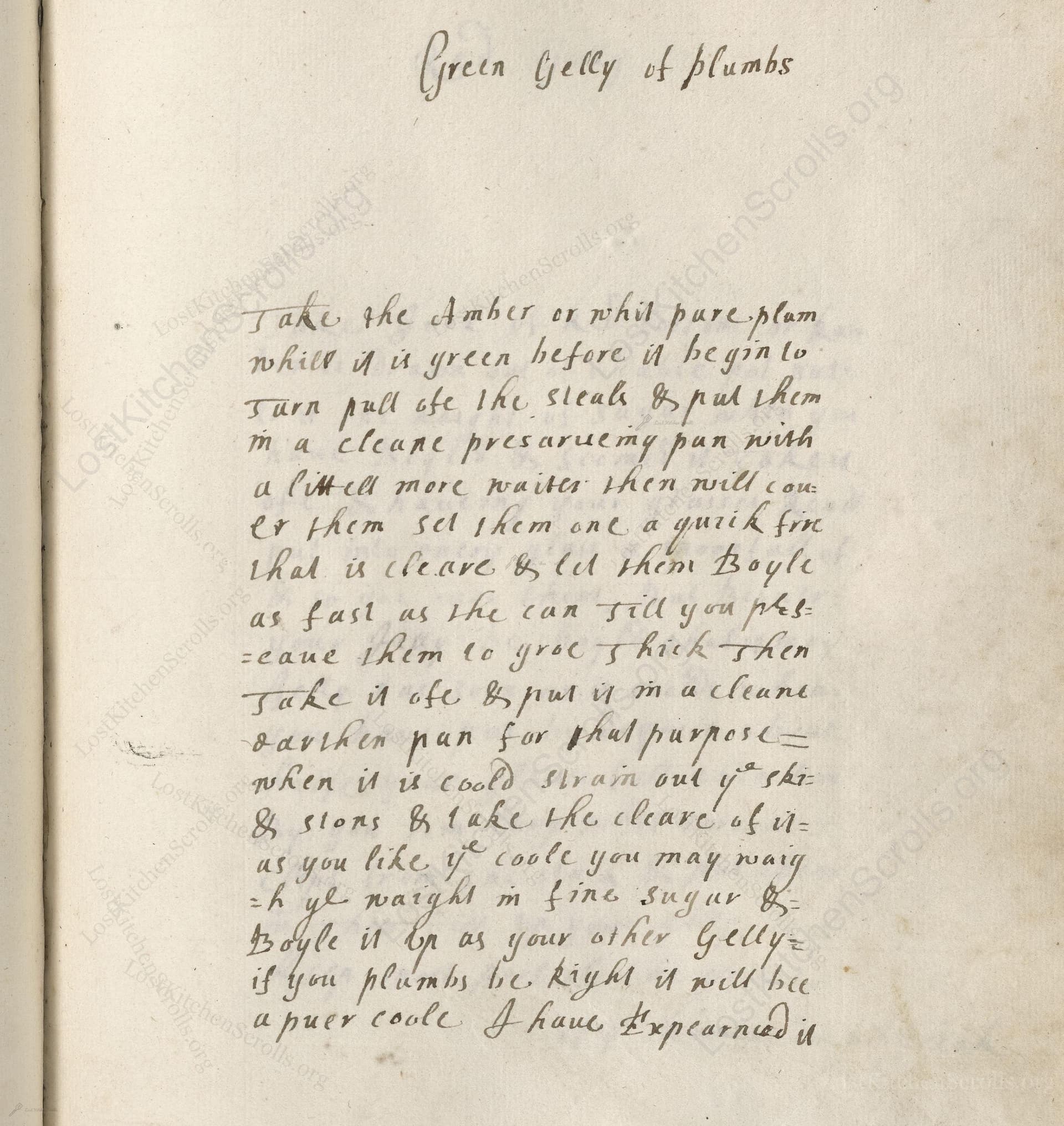Green Gelly Of Plumbs
From the treasured pages of Cookbook of Susanna Packe
Written by Susanna Packe

Green Gelly Of Plumbs
"Take the Amber or whit pure plum whill it is green before it begin to Turn pull ofe the steale & put them in a cleane presarueing pan with a littell more waiter then will couer them set them one a quick fire that is cleare & let them Boyle as fast as the can till you preseaue them to groe thick then Take it ofe & put it in a cleane earthen pan for that purpose= when it is coold strain out ye skin & stons & take the cleare of it= as you like ye coole you may wayh ye waight in fine sugar &= Boyle it up as your other Gelly= if you plumbs be Right it will bee a puer coole I haue Expearned it"
Note on the Original Text
The recipe is written as a conversational, almost narrative sequence—common for the era, assuming the reader had enough experience to fill in the gaps. Spellings are variable ('waight' for weight, 'couer' for cover), and punctuation inconsistent, typical of handwritten manuscript cookbooks before standardized spelling. It relies on sensory cues ('when you preseaue them to groe thick'), rather than measured times or temperatures, reflecting both the hands-on approach of historic kitchen practice and a lack of precise measuring equipment.

Title
Cookbook of Susanna Packe (1674)
You can also click the book image above to peruse the original tome
Writer
Susanna Packe
Era
1674
Publisher
Unknown
Background
A delightful culinary treasure from the 17th century, this book offers a charming glimpse into the flavors and techniques that graced English kitchens in Susanna Packe's time, promising a feast of history and taste for any food enthusiast.
Kindly made available by
Folger Shakespeare Library
The recipe comes from Susanna Packe's 1674 collection, a time when English gentlewomen often compiled household manuals of recipes and remedies. 'Amber or white pure plum' refers to early-harvested, hardly-ripened plums, prized for the clarity and tartness they brought to preserves and jellies. Sugar, still precious but increasingly available, was used in significant amounts to create shelf-stable confections like this. The goal was a jewel-bright, slightly tart, refreshing jelly—a vivid treat for the table and a demonstration of both skill and status.

In the 17th century, this preserve would be made in a wide, shallow 'preserving pan'—often of copper or earthenware—for fast, even boiling. Cooks used wooden spoons for stirring and coarser strainers or fine linen cloths for sieving the fruit from the juices. The mixture was poured into earthenware pans for cooling and later set in glass or ceramic jars. Quick, clear fires (from wood or coal) ensured the rapid boil critical for clarity.
Prep Time
10 mins
Cook Time
1 hr 30 mins
Servings
8
We've done our best to adapt this historical recipe for modern kitchens, but some details may still need refinement. We warmly welcome feedback from fellow cooks and culinary historians — your insights support the entire community!
Ingredients
- 2.2 lbs green (unripe) plums or substitute greengages or underripe white plums
- 5 cups water
- Fine white sugar (equal weight to strained plum juice, approximately 1.1 lbs per 2 cups juice)
Instructions
- To recreate this 17th-century 'Green Gelly of plumbs', start by sourcing green, unripe plums—about 2.2 lbs.
- Remove their stems and place them in a large saucepan, adding roughly 5 cups of water, just enough to more than cover the fruit.
- Bring the mixture to a vigorous boil over high heat, letting the fruit cook rapidly until it thickens slightly and the plums soften, which may take around 45 minutes to 1 hour.
- Once thick, take the pot off the heat and pour the mixture into a heatproof bowl.
- When cooled, strain out skins and stones, collecting only the jewel-clear liquid.
- For every 1.1 lbs of the strained plum juice, weigh out 1.1 lbs of fine white sugar.
- Return both to the cleaned pan and boil together, stirring occasionally, until the mixture sets into a translucent gel (reaching about 221°F on a sugar thermometer, or when a drop gels on a cold plate).
- Pour into clean jars or serving dishes and let set.
- You should end up with a beautifully clear green plum jelly.
Estimated Calories
180 per serving
Cooking Estimates
It takes about 10 minutes to prepare everything before you start cooking. Cooking the plums and boiling with sugar takes around 1 hour and 30 minutes in total. This recipe makes about 8 servings, and each serving has about 180 calories.
As noted above, we have made our best effort to translate and adapt this historical recipe for modern kitchens, taking into account ingredients nowadays, cooking techniques, measurements, and so on. However, historical recipes often contain assumptions that require interpretation.
We'd love for anyone to help improve these adaptations. Community contributions are highly welcome. If you have suggestions, corrections, or cooking tips based on your experience with this recipe, please share them below.
Join the Discussion
Rate This Recipe
Dietary Preference
Main Ingredients
Culinary Technique

Den Bockfisch In Einer Fleisch Suppen Zu Kochen
This recipe hails from a German manuscript cookbook compiled in 1696, a time whe...

Die Grieß Nudlen Zumachen
This recipe comes from a rather mysterious manuscript cookbook, penned anonymous...

Ein Boudain
This recipe comes from an anonymous German-language manuscript cookbook from 169...

Ein Gesaltzen Citroni
This recipe, dating from 1696, comes from an extensive anonymous German cookbook...
Browse our complete collection of time-honored recipes



